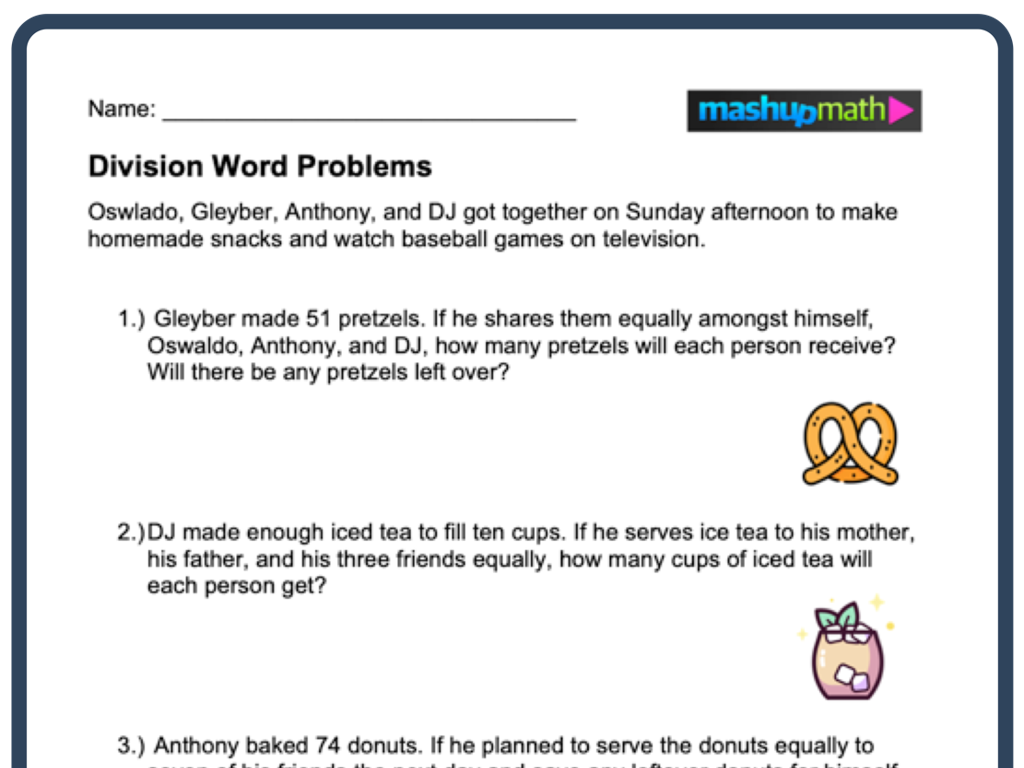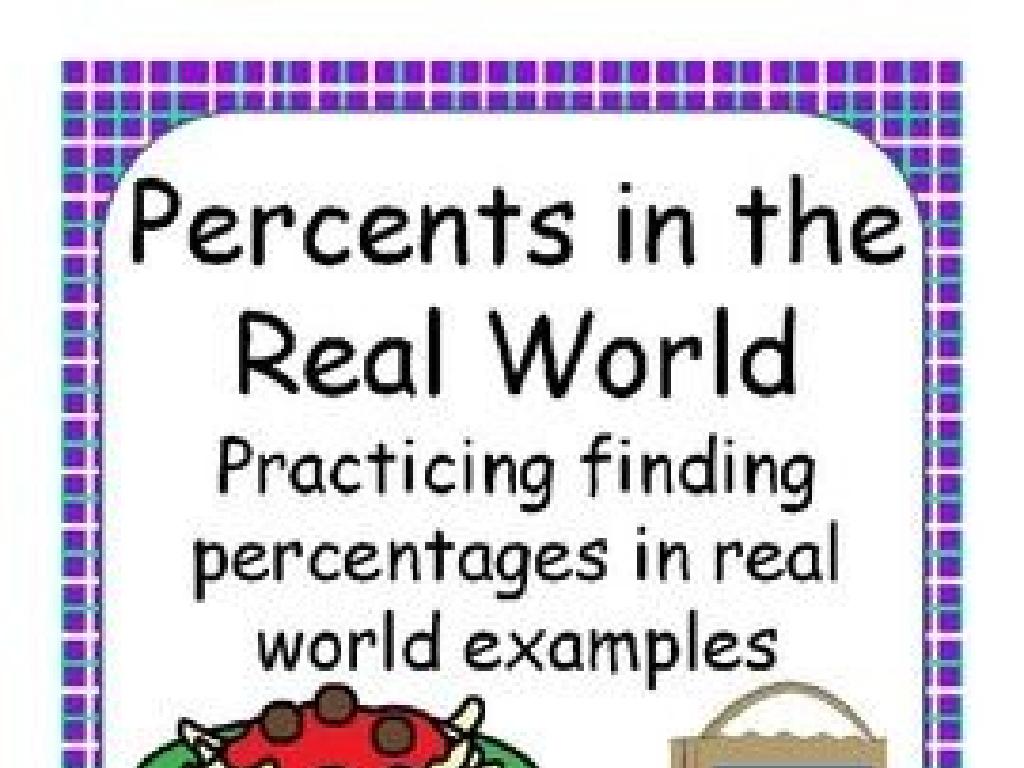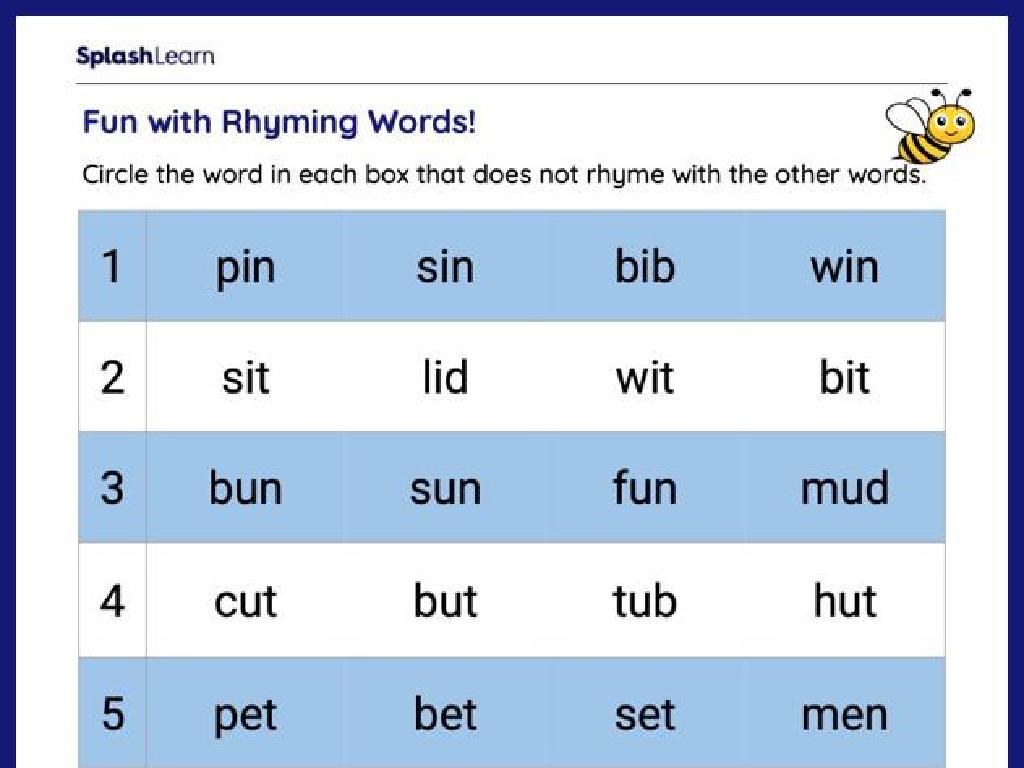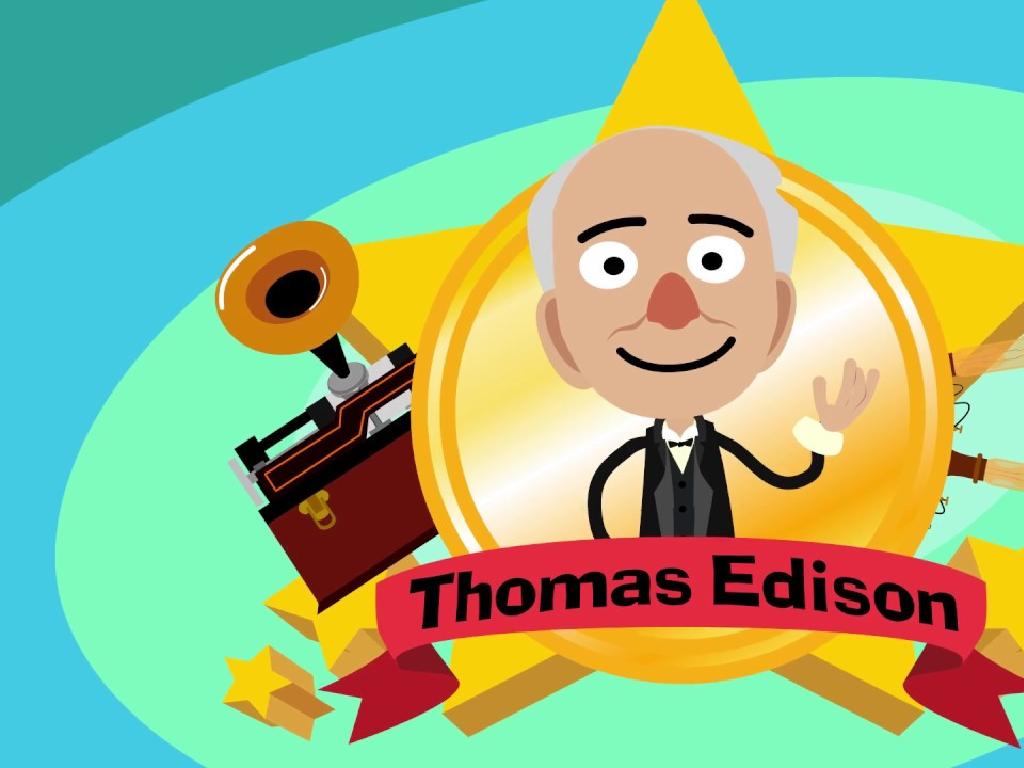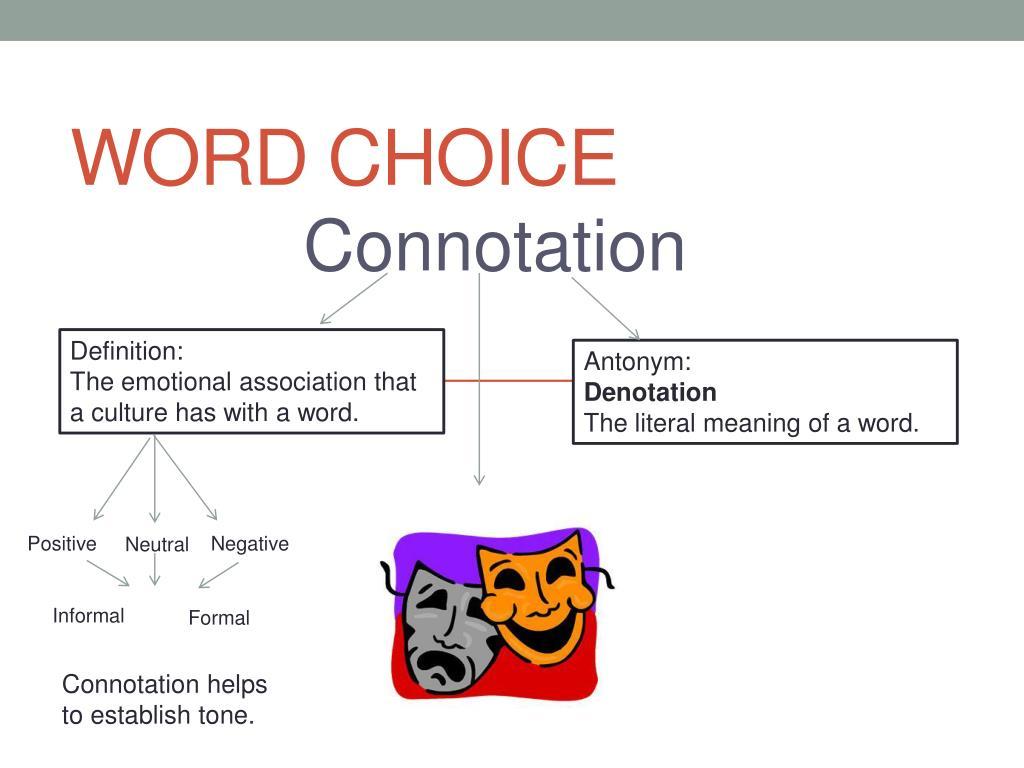Write Equations With Unknown Numbers To Represent Word Problems: Multiplication And Division Only
Subject: Math
Grade: Third grade
Topic: Equations With Unknown Numbers
Please LOG IN to download the presentation. Access is available to registered users only.
View More Content
Today’s Adventure: Equations with Unknown Numbers!
– What is an equation?
– An equation is like a math sentence that shows two things are equal.
– Multiplication & Division basics
– Multiplication is repeated addition, division is sharing equally.
– Equations as problem solvers
– Equations can find a mystery number in a story.
– Practice with word problems
– We’ll use clues from stories to write equations and find answers.
|
This slide introduces third graders to the concept of equations with unknown numbers, focusing on multiplication and division. Start by explaining what an equation is, using simple terms and examples. Reinforce their understanding of multiplication as repeated addition and division as sharing equally. Illustrate how equations can be used to solve real-world problems, especially when there’s a number we don’t know yet. Encourage students to think of equations as detectives solving mysteries in word problems. Provide examples and plan for interactive activities where students can practice writing and solving equations based on word problems presented in class.
Understanding Equations
– Equations are math sentences
– Like a sentence tells a story, an equation shows a math fact.
– They show equal relationships
– When two things are the same, we use an equation to show it.
– Equations include numbers and ‘=’
– We use symbols like +, -, x, ÷, and = in equations.
– Example: 3 x 4 = 12
– This equation means ‘3 times 4 is the same as 12’.
|
Introduce the concept of equations to the students by comparing them to sentences that tell a story, but in the language of math. Explain that equations show that two things are equal or the same. Highlight the components of an equation, including numbers, operations (like addition, subtraction, multiplication, division), and the equal sign. Use simple multiplication examples to illustrate the concept. Encourage students to think of equations as balanced scales, where both sides must have the same value. Provide additional examples and ask students to identify the numbers, operations, and equal sign in each.
Mystery Numbers in Math Equations
– Understanding unknown numbers
– An unknown number is a number we need to find in an equation
– Symbols represent unknowns
– We can use symbols like ?, *, or letters like x or n
– Solving for the mystery number
– Use multiplication or division to discover the unknown
– Practice with word problems
– We’ll use clues from word problems to solve for unknowns
|
This slide introduces the concept of unknown numbers in equations, which is a fundamental part of solving math problems. Explain to the students that sometimes in math, we come across a number we don’t know, and we call this the ‘unknown number.’ We can use different symbols or letters to represent these unknowns. The goal is to figure out what these mystery numbers are by using multiplication and division. Provide examples of word problems and guide the students through the process of identifying the unknown and solving for it. Encourage the students to practice with different word problems to become comfortable with finding the unknown number.
Multiplication with Unknowns
– Multiplying makes equal groups
– Unknowns in multiplication
If we know the total and group size, but not how many groups, one number is unknown.
– Example: 4 x ? = 20
Here, ‘?’ represents the number of groups that make 20 when 4 are in each group.
– Solving for the unknown
To find ‘?’, we divide 20 by 4, which equals 5. So, ‘?’ is 5.
|
This slide introduces the concept of unknowns in multiplication for third-grade students. Start by explaining that multiplication is about combining equal groups. When one of the numbers in a multiplication problem is missing, it’s called an unknown. Use the example 4 x ? = 20 to illustrate this concept. Show students how to find the unknown by dividing the total by the size of each group. Encourage them to think of it as a mystery they get to solve and emphasize that understanding the relationship between multiplication and division is key to finding the unknown number.
Division with Unknowns
– Division creates equal parts
– Unknowns in division problems
When we know the total and number of parts but not the size of each part, one part is the unknown.
– Example: 15 ÷ ? = 3
To find ‘?’, think: what number times 3 equals 15?
– Solving for the unknown
We can find the unknown by multiplying the known parts.
|
This slide introduces the concept of division with unknowns to third-grade students. Start by explaining that division is a way to split a total amount into equal parts. Emphasize that sometimes we don’t know the size of each part, and that’s when we have an unknown in our equation. Use the example 15 ÷ ? = 3 to illustrate this point. Ask the students what number times 3 gives us 15 to help them understand how to find the unknown. This will lead them to the answer that ‘?’ is 5. Encourage students to practice with similar problems and reassure them that it’s like solving a mystery they have clues (the total and the number of parts) and they need to find the missing piece (the size of each part).
Multiplication Word Problems
– Word problems are number stories
– Equations represent these stories
– Example: Alex’s apple bags
– If 3 bags have 15 apples, equation is 3 x ? = 15
– Solve for unknown numbers
– Divide total apples by number of bags to find each bag’s apples
|
This slide introduces students to the concept of using multiplication to solve word problems. Start by explaining that word problems tell a story about numbers and we can use equations to represent these stories. Use the example of Alex and his apple bags to illustrate how to write an equation for a given problem. Emphasize that the unknown number, represented by a question mark or a variable, is what we’re trying to find. Teach the students how to solve for the unknown by dividing the total number of apples by the number of bags. Encourage students to think of similar stories and create equations that match them. This will help them understand the concept of multiplication as repeated addition and how it applies to real-world situations.
Division Word Problems
– Understanding division in stories
– Writing equations for fair sharing
– Example: Sharing cookies equally
– If 12 cookies are shared by 4 friends, how many does each get?
– Solving the cookie problem
– We divide 12 cookies by 4 friends to find the answer.
|
This slide introduces students to division word problems, which often involve scenarios of sharing or grouping items equally. Start by explaining that division is a way to find out how many items each person or group receives when sharing things evenly. Use the cookie example to show how to write an equation for the problem: 12 cookies ÷ 4 friends = ? cookies per friend. Work through the problem with the class, demonstrating how to divide the total number of cookies by the number of friends to find out how many cookies each friend gets. Encourage students to visualize the problem with actual objects or drawings to aid their understanding.
Let’s Practice Together: Solving Word Problems
– Write an equation from a word problem
– I’ll show a problem, we’ll form the equation together
– Solve for the unknown number
– Use multiplication or division to find the answer
– Embrace mistakes as learning opportunities
– Every mistake is a step towards mastering math
– Practice makes perfect
|
This slide is an interactive class activity designed to engage students in the process of translating word problems into mathematical equations and solving for unknowns using multiplication and division. Start by presenting a word problem to the class and guide them through the process of writing the corresponding equation. Emphasize that making mistakes is a natural part of learning and encourage students to try without fear of getting it wrong. Provide positive reinforcement as they work through the problems. Possible activities include solving problems as a class, in small groups, or individually, with varying levels of difficulty to cater to different learning paces.
Class Activity: Equation Detectives
– Become Equation Detectives
– Solve mystery word problems
– Use multiplication/division to solve problems
– Work together in pairs
– Discuss and find unknowns
– Use ‘x’ or ‘÷’ to replace the unknown number
|
In this engaging class activity, students will pair up and act as ‘Equation Detectives’ to solve word problems that involve multiplication and division. Provide worksheets with a variety of word problems where students have to identify the unknown number and write an equation to represent the problem. Encourage them to discuss their thought process with their partner and use mathematical symbols correctly. As a teacher, circulate the room to guide discussions and ensure understanding. Possible activities: 1) Finding the number of items in groups, 2) Dividing items evenly among people, 3) Multiplying to find total items in arrays, 4) Using division to solve ‘how many groups’ problems. This activity will help students grasp the concept of unknown numbers in equations and enhance their problem-solving skills.
Super Sleuths of Math: Conclusion
– Congratulations, Math Detectives!
– Mastered equations with unknowns
– You can now write and solve multiplication and division problems with a mystery number
– Equations are math stories
– Just like a story has a beginning, middle, and end, equations have numbers, unknowns, and an equal sign
– Keep practicing your skills
|
Well done to the class for their hard work in learning how to write and solve equations with unknown numbers. It’s important to reinforce the concept that equations are like stories in math, with a beginning (the first number), middle (the operation and unknown number), and end (the result after the equal sign). Encourage the students to continue practicing these skills, as they are fundamental to understanding more complex math problems in the future. Remind them that with each equation they solve, they’re becoming more confident and capable math detectives.

